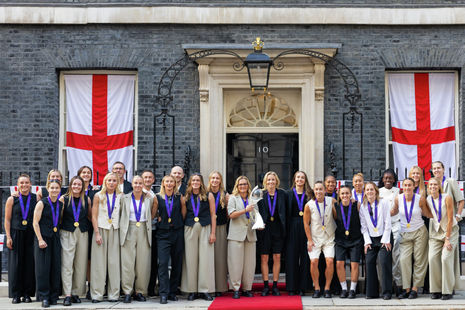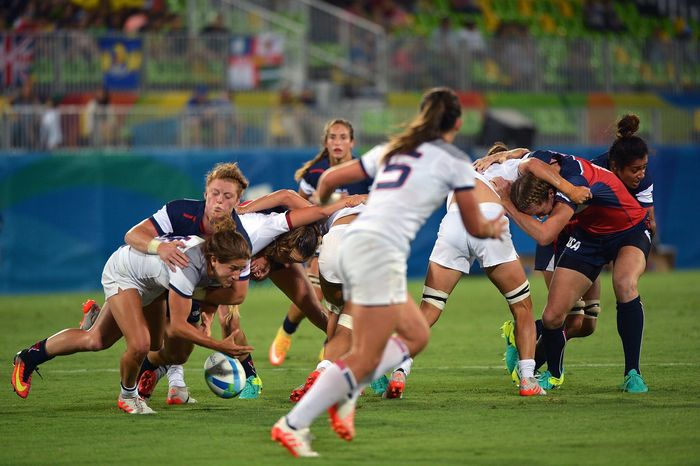Shrinking the goals: why modifying women’s sport misses the point
Ben Lubitsh argues that reshaping women’s sport is not the answer to its disappointing engagement

Last month, the Lionesses lifted the Euros trophy for the second time running. And yet, somewhat expectedly, the celebrations never truly seemed to catch fire. Yes, there were headlines, a parade, and a surge of pride – but the streets weren’t filled for weeks. The story faded faster than it deserved to.
Indeed, this disappointing reaction demonstrates that problems with engagement in women’s sports are not magically disappearing. Perhaps, as some have suggested, the solution to this lies in modifying women’s sports to make them more entertaining for the average viewer. In football, for instance, this might mean smaller pitches and goals. In basketball, it may be about lowering the rims so more women can dunk. The theory is simple: more quick and flashy moments would lead to more viewers, which would generate more financial growth for the sport.
It’s an argument often made in good faith – after all, most people advocating it want women’s sport to succeed. But it’s also one we must reject. Not just because it risks cheapening the product, but because it misunderstands both sport itself and the culture that sustains it.
Firstly, at its very core, this thinking assumes that the way to make women’s sport more watchable is to make it more like the men’s game. That’s a deeply flawed starting point. It sets the men’s version as the ‘gold standard’ and suggests that women must replicate it – or else be considered inferior.
Take the WNBA as an example. The idea of lowering rims so players can dunk more is framed as a way to generate excitement. But why should dunking be the yardstick for entertainment? We already have elite passing, pinpoint shooting, defensive chess matches, and tense fourth quarters; saying the game needs more dunks is to say those things aren’t enough, when in fact they are the heart of the sport.
“Changing the physical parameters to chase a particular kind of spectacle reinforces a patriarchal idea”
Sport is inherently gender-neutral in its objectives: score more points than your opponent. The drama, the storylines, the rivalries, and the emotional highs and lows exist in both men’s and women’s competitions. Changing the physical parameters to chase a particular kind of spectacle reinforces the patriarchal idea that women’s sport is only worth watching if it mimics the most superficial thrills of the men’s game. That’s not just wrongheaded; it’s sexist.
Even if modifications did bring more viewers, we have to ask: what kind of fans would they bring?
Sports fans exist on a spectrum. On one end is the analyst – the type who lives for stats and tactical breakdowns. For them, the thrill comes from reading the numbers, understanding the strategies, and dissecting the game like a scientist.
On the other end is the ‘eye test’ fan – driven entirely by spectacle. They watch for ankle-breaking crossovers, last-second three-pointers, bicycle kicks, and outrageous celebrations. They might binge YouTube highlight reels but tune out during a tight, strategic 1–0 win.
Somewhere in the middle lies the fan that every sport deserves – the perfect balance of both. They appreciate a gritty defensive battle and a dazzling goal. They love the numbers but also value the moments you can’t quantify. They see athletes as people first, competitors second, and entertainers third.
Every sport thrives when its fan base is defined by this type of nuance. Too many analysts, and players are reduced to data points in spreadsheets. Too many eye test fans, and players become circus animals – valued only for how often they can produce jaw-dropping moments. Both extremes can make the culture toxic and the pressure unsustainable.
Modifying women’s sport for ‘more entertainment’ would inevitably tilt the balance toward eye test fans. You might get more casual viewers, but they’d be there for the spectacle, not the substance. That’s a short-term dopamine hit, not a sustainable fan culture. And women’s sport deserves the same long-term stability and respect that men’s sport has been allowed to build over decades.
“If we build the right type of fan base for women’s sport, the excitement will take care of itself”
If the goal, then, is to grow women’s sport – to make Euros wins resonate for weeks, to fill stadiums season after season – the answer isn’t to change the game, but rather to change the culture around it.
That means us – the fans – choosing to show up not just for the highlight moments, but for the grind, the craft, and the narrative arcs that make sport worth following. Fan culture isn’t just a by-product of the sport; it’s the environment that players and leagues adapt to. If we build the right type of fan base for women’s sport, the excitement will take care of itself.
So no, don’t shrink the goals. Don’t lower the rims. Don’t try to turn women’s sport into a carnival act to grab a few more eyeballs. If we want the Lionesses’ next win to set the country alight, the change has to start in the stands, not on the pitch.
 News / Cambridge academics stand out in King’s 2026 Honours List2 January 2026
News / Cambridge academics stand out in King’s 2026 Honours List2 January 2026 Interviews / You don’t need to peak at Cambridge, says Robin Harding31 December 2025
Interviews / You don’t need to peak at Cambridge, says Robin Harding31 December 2025 Comment / What happened to men at Cambridge?31 December 2025
Comment / What happened to men at Cambridge?31 December 2025 News / AstraZeneca sues for £32 million over faulty construction at Cambridge Campus31 December 2025
News / AstraZeneca sues for £32 million over faulty construction at Cambridge Campus31 December 2025 Features / “It’s a momentary expression of rage”: reforming democracy from Cambridge4 January 2026
Features / “It’s a momentary expression of rage”: reforming democracy from Cambridge4 January 2026










